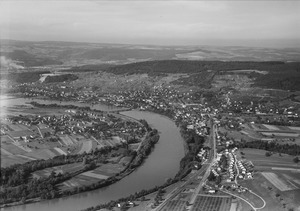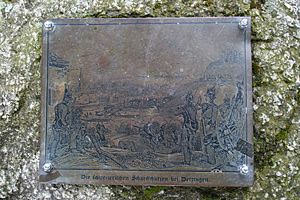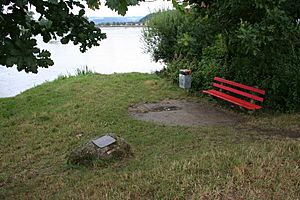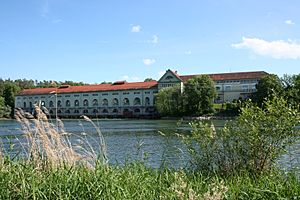Döttingen, Aargau facts for kids
Quick facts for kids
Döttingen
|
||
|---|---|---|
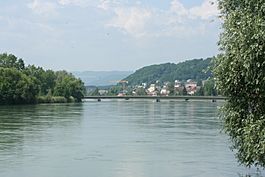 |
||
|
||
| Country | Switzerland | |
| Canton | Aargau | |
| District | Zurzach | |
| Area | ||
| • Total | 6.93 km2 (2.68 sq mi) | |
| Elevation | 328 m (1,076 ft) | |
| Population
(Dec 2020 )
|
||
| • Total | 4,244 | |
| • Density | 612.4/km2 (1,586.1/sq mi) | |
| Postal code |
5312
|
|
| Surrounded by | Böttstein, Klingnau, Tegerfelden, Würenlingen, Zurzach | |
Döttingen is a town in the Zurzach district. It is located in the canton of Aargau in Switzerland.
Contents
History of Döttingen
Döttingen has a long history. People lived here during the Neolithic period, which was the New Stone Age. Also, two old Roman farms have been found in the area.
The town of Döttingen was first written about in the year 1239. Back then, it was called Totingen. For a long time, until the 1800s, it was also known as Grossdöttingen.
A famous monastery, Sankt Blasien Abbey in the Black Forest, owned a lot of land in Döttingen. They even had a large house in the village.
The Battle of 1799
In March 1798, the French Army came into Switzerland. They created a new government called the Helvetic Republic. Döttingen became a part of a new area called the Canton of Baden.
During a war in 1799, the French and Austrian armies faced each other. The Aare river was the dividing line between them. On August 17, 1799, Austrian soldiers tried to cross the Aare river at Döttingen. They fired cannons at the French army on the other side. The French fired back and stopped the Austrians from crossing.
Sadly, two nearby villages, Kleindöttingen and Eien, were completely destroyed. Many people also lost their lives. Today, Döttingen holds a festival called Übereschüsset every two years to remember this important event.
Modern Development
Before 1848, Döttingen was part of the Klingnau church area. In 1961, a new Catholic Church, St. John, was built in the town.
For a long time, Döttingen's economy relied on farming and growing grapes for wine. But when the railway arrived in 1859, things changed. Döttingen grew into a center for industry, especially for processing wood.
Later, power plants were built here. A hydroelectric plant was built in 1902. Then, an oil-fired power plant was added in 1948. In the late 1960s and early 1970s, two parts of a nuclear power plant (NOK) were also built. By the year 2000, most people in Döttingen worked in manufacturing.
Since 1950, Döttingen has hosted the biggest Wine Festival in German-speaking Switzerland every year.
Geography of Döttingen
Döttingen covers an area of about 6.92 square kilometers (2.67 square miles). A large part of this land is covered by forests, about 34.8%. Another 32.5% is used for farming. About 26.2% of the land has buildings or roads. Rivers and lakes make up about 6.8% of the area.
The town is located in the Zurzach district. It sits where the Surb river flows into the Aare river. Döttingen and the nearby town of Klingnau form an important center in the lower Aare valley. Döttingen is a haufendorf village, which means it grew without a clear plan, with buildings packed closely together around a central area. It also includes the small village of Kleindöttingen.
Coat of Arms
The coat of arms for Döttingen is described as: Per fess Or and Sable a Pale counterchanged. This means it has a design split horizontally into two parts. The top part is gold (Or) and the bottom part is black (Sable). There is a vertical stripe (Pale) that changes color where it crosses the horizontal line. So, the part of the stripe in the gold section is black, and the part in the black section is gold.
Population and People
Döttingen has a population of about 4,304 people as of 2022. About 39.1% of the people living here are from other countries.
Most people in Döttingen speak German, about 76.2%. The next most common languages are Italian (7.8%) and Albanian (4.4%).
Age Groups
Looking at the age of people in Döttingen (as of 2008):
- About 10.3% are children aged 0-9 years old.
- About 12.5% are teenagers aged 10-19 years old.
- About 13.2% are young adults aged 20-29 years old.
- About 16.3% are adults aged 40-49 years old.
- About 10.4% are older adults aged 60-69 years old.
Homes and Households
As of 2000, there were about 1,266 homes and apartments in Döttingen. On average, there were 2.5 people living in each home. About 48.2% of the homes were owned by the people living in them.
In 2008, there were 515 single-family homes in Döttingen. This was about 36% of all homes and apartments.
Economy of Döttingen
In 2007, the unemployment rate in Döttingen was 3.22%.
The town's economy is divided into three main parts:
- Primary sector: This includes farming and other activities that use natural resources. About 48 people work in this area.
- Secondary sector: This involves manufacturing and industry. About 1,000 people work in this sector.
- Tertiary sector: This covers services, like shops, offices, and schools. About 645 people work in this sector.
Many people who live in Döttingen travel to other towns for work. Also, many people from other places come to Döttingen to work. About 12.3% of workers use public transport, while 54.1% use a private car to get to work.
Religion
According to the 2000 census:
- About 57.5% of the people were Roman Catholic.
- About 15.9% belonged to the Swiss Reformed Church.
Education
Switzerland has a very good education system. In Döttingen, about 58.1% of adults (aged 25-64) have finished high school or gone on to higher education, like university.
In the 2008/2009 school year:
- 295 students attended primary school in Döttingen.
- 115 students attended secondary school in the town.
See also
 In Spanish: Döttingen para niños
In Spanish: Döttingen para niños





